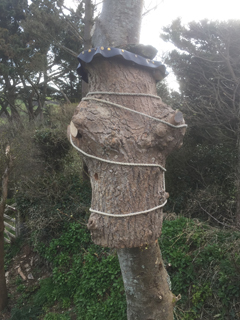 Bang! The cold weather has arrived, as we knew it would, and winter seems a lot nearer now than it did last week. Whilst my bee colonies have clustered for the first time this autumn and stayed indoors during the really cold weather as a result, a week ago the bees were still flying and bringing in pollen and nectar, and the wasps were doing their utmost to steal what was being brought in. As ever, though, it was the weakest colonies that the wasps predated, with one of my hives (a late swarm) taking a real hammering.
Bang! The cold weather has arrived, as we knew it would, and winter seems a lot nearer now than it did last week. Whilst my bee colonies have clustered for the first time this autumn and stayed indoors during the really cold weather as a result, a week ago the bees were still flying and bringing in pollen and nectar, and the wasps were doing their utmost to steal what was being brought in. As ever, though, it was the weakest colonies that the wasps predated, with one of my hives (a late swarm) taking a real hammering.
I have three wasp traps outside the hive and one inside the outer boxes on the crown-board, and they have all been filling on a daily basis. The bees are still flying however, as if they are unaware of what is happening. There is feed on the hive, so they are at least able to replenish any losses (though the wasps are getting to this as well!). Another colony, which had laying workers and was doomed anyway so I left as a sacrificial hive, looks like Wasp Central with the amount of wasp traffic entering and leaving. No interest being shown in wasp traps outside this hive!
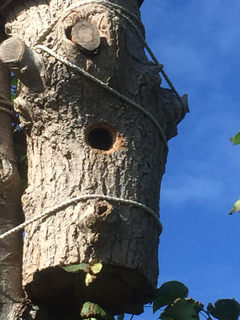
Good news! My log hive, that I talked about back in April/May time, is at last occupied! Unfortunately though, not by honey bees! We had heard a knocking sound whilst lunching in the garden during the past few weeks, which we thought was coming across the valley and was somebody working in their garden, building something, or erecting fence posts. It turns out the noise was a woodpecker (green, I believe) inside the log hive, tidying it up or making the cavity inside larger. I always checked the log hive when visiting my apiary, looking for bee activity, and had noticed the entrance seemed to be bigger than when it was first installed, but thought nothing of it. We now know what the knocking sound was and are delighted with our new resident(s) – I shall now have to make another log hive ready for next year and hope that territorially I will be able to place it near enough to the present one to deter further nest-making!
Last Thursday, at our monthly Roseland Beekeeping Group meeting, we had a visit and presentation from one of our former members who emigrated to France 2 years ago. She had returned to the country where she had previously lived for many years to avoid the consequences of Brexit – and fell right into the midst of the Asian Hornet intrusion! She didn’t explain which was the lesser of the two evils but did give us all (there were about 50 of us present) a very good insight into what beekeeping was like in an Asian Hornet environment.
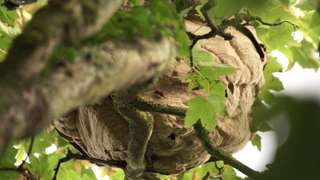 The secret apparently – apart from catching hawking hornets with a butterfly net (a bit like me with my tennis racquet and the wasps!) is to maintain small hive entrances all year round. This is contrary to what we normally do here in the UK – we normally have wide open entrances in the summer to allow easy access in and out during periods of high nectar flow when the bees are really busy, but close them down to smaller openings at the end of July/beginning of August so that the bees can more easily defend against robbing bees and wasps. The “queuing” at the entrance that results from the small entrance is not a problem to the bees – they will get in eventually – but is an added deterrent to the hornet, as it can’t get past so many bees.
The secret apparently – apart from catching hawking hornets with a butterfly net (a bit like me with my tennis racquet and the wasps!) is to maintain small hive entrances all year round. This is contrary to what we normally do here in the UK – we normally have wide open entrances in the summer to allow easy access in and out during periods of high nectar flow when the bees are really busy, but close them down to smaller openings at the end of July/beginning of August so that the bees can more easily defend against robbing bees and wasps. The “queuing” at the entrance that results from the small entrance is not a problem to the bees – they will get in eventually – but is an added deterrent to the hornet, as it can’t get past so many bees.
The French bees adopt various strategies to cope with predation by Asian Hornets. Firstly, they will come out in “assault” parties of about 10 bees or so and harass the marauder so that it either gives up trying or at least fails to gain access to the hive. Whilst “hawking” in front of the hive is not nice to see (the Asian Hornet bites off the head and abdomen of the bee close to the hive and then flies back to its nest with the thorax, the most nutritious part), the effect on the colony is not, at least in the early stages of assault, too deleterious, as the queen is laying at a far faster rate than the hornet can predate. However, if it once gains access to the hive it will start to devour and steal the brood – that does have a significant impact on the colony, which invariably succumbs to such activity.
Secondly – quite sensibly really – they hunker down and stay in the hive, so the hornets have nothing on which to predate and hopefully will go off and look for easier pickings!
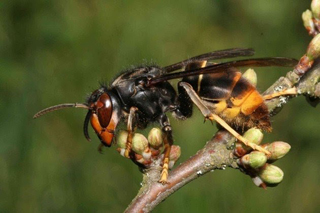
Trapping of hornets at this time of year is something we hear a lot about, certainly as beekeepers, but apparently that is done mainly to give the beekeeper the same kind of satisfaction that I get from using my tennis racquet! It has little impact on a pest whose nest can produce up to something like 20,000 hornets and, like my wasp nests, can sustain considerable losses with negligible impact on the colony – which is coming to the end of its season and will die out in the late autumn anyway.
The emphasis at this time of year must therefore be on locating the hornets’ nest, as it is in the autumn that the nest produces new queens which will go off and mate before hibernating for the winter – again, just like the wasps and also our European hornets. The reason that spotting and locating the nests is so important is that each Asian Hornet nest can produce up to 500 queens at this time of year!!
Yes, that’s right – 500!! Each of these will be capable, in theory, of setting up new colonies next spring – whilst in practice only about 10% are successful, that is still 50 potential new nests. The new colonies would then wreak the havoc here that is to be found in France –WHERE NO ACTION WAS TAKEN WHEN ASIAN HORNET WAS FIRST IDENTIFIED! The French government has been totally disinterested in the situation, leaving it to the local “mairies” to handle on a regional basis. As a consequence, there is no coordinated approach to solving the problem of Asian Hornet ingress in France, since some regional “mairies” are pro-active whilst others are “laisser-faire” (well, they would be in France, wouldn’t they?!).
Also, there is no equivalent to DEFRA or the NBU (the National Bee Unit) in France, so beekeepers are very much on their own in fighting this battle. We in the UK must ensure that we do not lose our NBU. The Bee Inspectors who work there are a hugely valuable asset to beekeeping and to the country at large, as it is they who are the last line of defence, devising programmes to prevent the incursion of, or to control, such pests once they arrive.
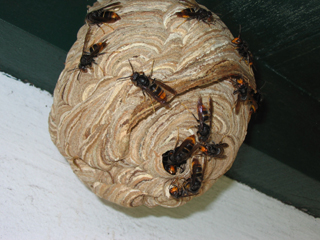
However, there are not enough of them should the Asian Hornet actually establish itself here, as the single sightings so far recorded result in a “hit team” of inspectors descending on the area concerned and doing “finger-tip” searches to locate the nests. This decimates the NBU and prevents the normal work of the Bee Inspectors from taking place, so we could end up with disease outbreaks with no Inspectors available to respond and assist if they are responding to an Asian Hornet sighting. We would then possibly end up with these outbreaks causing more problems than the Asian Hornet and bee colonies dying out through lack of appropriate technical support.
This is why we beekeepers on the Roseland have set up an Asian Hornet Hit Team (AHAT) to protect against establishment of the pest, and this is taking off all around the UK thanks to an earlier initiative in Devon. The aim is to be the first line of defence and to positively identify suspected sightings so that when the NBU is called in it is to positive sightings, rather than false call-outs.
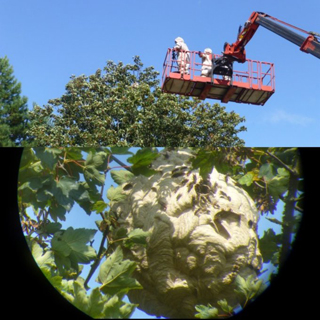 So, who would be a beekeeper in this day and age? Well, I have 21 students currently going through the first stages of education and wanting to keep bees. In the Spring (well, in the New Year!) I will hopefully have similar numbers again. So there is a lot of interest being shown in beekeeping. People are becoming more and more aware of how important – nay, essential – bees are to mankind’s continued existence on this planet. We must not allow the Asian Hornet to establish here in the UK, so it is good to know there will be more beekeepers around to assist in the fight.
So, who would be a beekeeper in this day and age? Well, I have 21 students currently going through the first stages of education and wanting to keep bees. In the Spring (well, in the New Year!) I will hopefully have similar numbers again. So there is a lot of interest being shown in beekeeping. People are becoming more and more aware of how important – nay, essential – bees are to mankind’s continued existence on this planet. We must not allow the Asian Hornet to establish here in the UK, so it is good to know there will be more beekeepers around to assist in the fight.
Having said that, it is equally important that the general public are made aware of the threat facing the UK and keep an eye open for nests. The ones high up in the trees are often not spotted until leaf-fall, so now is a good time to walk around looking up into the tops of trees. Any sighting should then be reported to alertnonnative@ceh.ac.uk or your local beekeeping group (me, for example, on the Roseland). Similarly, if an unusual-looking “wasp” or “hornet” is spotted, contact any beekeeper (me included) so that we can involve the AHAT. Try to either capture the insect (Asian Hornets are quite non-aggressive to humans away from their nest) or photograph it so we can confirm a positive or negative sighting.
That’s more than enough for this month. Keep your eyes peeled!
Colin Rees 01872 501313 – 07939 971104
